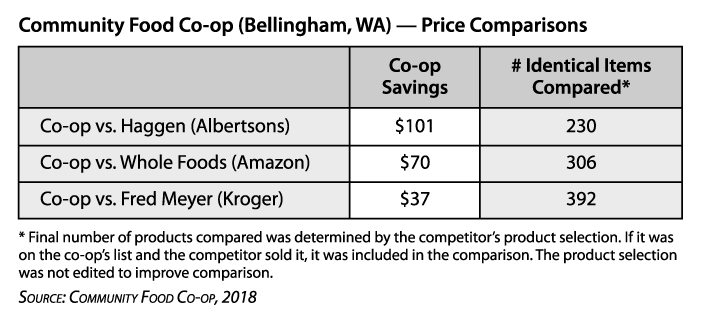On Prices – Where to begin?
Any grocery store or food co-op discussion will almost certainly delve into the realm of food prices. Be prepared!
Store profits are customer profits
As a baseline, describe how food co-ops can’t possibly gouge or take advantage of their customers because food co-ops are owned by their customers. Any store profits are customer profits. Those profits might be returned back into the store to improve operations and grow the co-op’s impact. Profits may go back into the community through the co-op’s giving programs. In many cases, profits are returned right back to customers at the end of the year – literally. With this closed loop, no matter the type of food on the shelf, prices at food co-ops are a better reflection of the true cost of grocery store food.
True Cost of Food
Beyond the closed economic loop of the store itself, the ‘true cost’ of food is also determined by food production methods. It simply costs more to pay a local farmer a living wage to harvest local strawberries than it does to pay a seasonal migrant laborer living in sometimes cramped and deplorable conditions (as documented by Min Sook Lee in the award-winning film Migrant Dreams). In the dominant food system, much of the true cost of food is externalized through the costs of a changing climate, the costs associated with treating poor health, or through the costs arising out of conflicts over finite resources.
Transparency
Financial statements of food co-ops are available to all member-owners. Wish to speak with a board director or manager about the co-op’s financial decisions? Never a problem. The head-office of an independent food co-op is usually right in the store itself.
The Myth of “More Expensive”
excerpt: Chapter 7
Because food co-ops are not trying to extract every last penny out of consumers, in many cases – a grocery basket of identical foods from a chain retailer is more expensive than from a food co-op. One co-op in Bellingham, WA, published their findings to demonstrate this (see adjacent table).
Read a more detailed price comparison of identical products.
Making Food More Accessible
Many food co-ops offer everyday discounts of 10-20% for members who qualify for low-income assistance.
Many food co-ops offer periodic sales at near wholesale pricing.
Through National Co-op Grocers, the combined purchasing power of 143 food co-ops in the U.S. supports the Co-op Basics program of highly-accessible prices on many staple foods.


